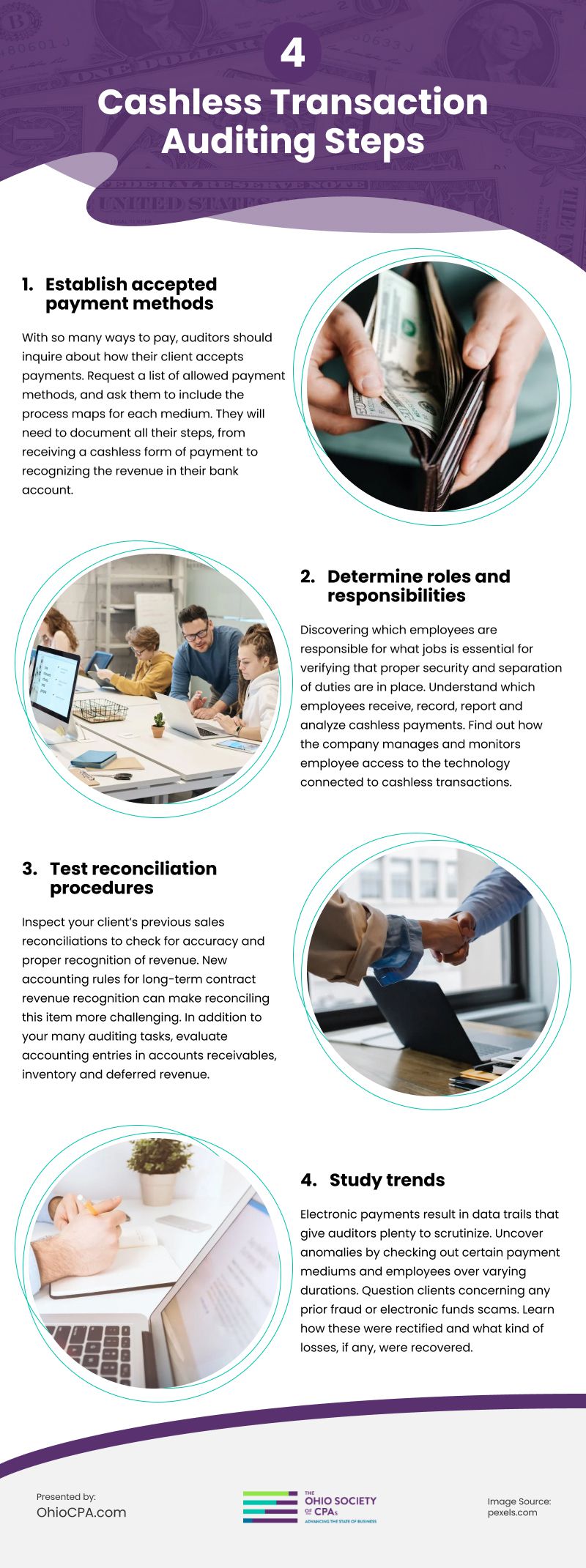
Cashless transactions have become so prevalent today that using paper currency for purchases may raise suspicion. Business owners can attract more customers by transitioning to cashless payment methods.
Our cashless economy has alleviated some financial concerns, making it faster and more convenient than handling physical money and offering greater security than traditional methods. It enhances transparency and accountability in transactions while simplifying record-keeping.
However, like any innovation, cashless payment systems have their drawbacks. In this scenario, heightened security risks emerge. Weak controls or inadequate separation of duties can leave organizations vulnerable to internal fraud. Additionally, cashless transactions may exclude economically disadvantaged populations who rely heavily on cash.
This infographic explores the four essential steps that guide auditors through scrutinizing electronic payments.
Four steps for auditing cashless transactions
In today’s digital era, physical cash exchanges have become increasingly rare. This shift prompts many accountants to question: “How do cashless transactions impact auditing?” With many methods for processing cashless payments, auditors must meticulously compile and monitor their clients’ electronic sales data from diverse channels, which can be labor-intensive.
However, by adhering to a structured approach such as the four-step process outlined below, accountants can ensure thorough aggregation and examination of essential records.
1. Establish accepted payment methods
Auditors should request a comprehensive list of approved payment methods from the client, accompanied by process maps detailing each medium. Clients should document every step, from receiving a cashless payment to recording the revenue in their bank account.
To facilitate the process, auditors may find it beneficial to proactively send an email template to clients before the audit, outlining the information required for preparation. This proactive approach ensures a seamless start to the audit process for all parties involved.
2. Determine roles and responsibilities
Identifying the employees responsible for specific tasks is crucial to ensure adequate security and separation of duties. It’s vital to ascertain which employees handle tasks such as receiving, recording, reporting, and analyzing cashless payments. Additionally, understanding how the company oversees and regulates employee access to technology associated with cashless transactions is imperative.
3. Test reconciliation procedures
Review your client’s past sales reconciliations to ensure accuracy and proper revenue recognition, especially given the complexity introduced by new accounting rules for long-term contract revenue. Assess accounting entries related to accounts receivable, inventory, and deferred revenue alongside your auditing duties.
4. Study trends
Electronic payments create data trails that offer auditors ample material for scrutiny. Identify anomalies by examining specific payment channels and employee activities across different time frames. Inquire with clients about any past instances of fraud or electronic funds scams, including the measures taken to address them and any potential losses recovered.
Successful auditing of cashless payments
The four-step process for auditing cashless transactions serves as a roadmap for auditors as they navigate the numerous options available to their clients. While four steps may appear concise, the actual procedure is far-reaching.
Given the myriad ways to conduct transactions with customers and vendors, thoroughness is paramount in tracing the data trail. Despite being few in number, the four steps had a significant influence.
source: https://ohiocpa.com/getinvolved/news/2023/08/23/auditing-cashless-transactions-a-four-step-guide
Comments
Download this infographic.
